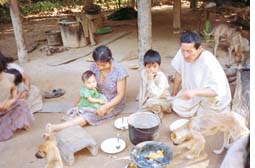Dietary guidelines for India 2024
The Indian Council of Medical Research (ICMR) recently revised the dietary guidelines for Indians to provide healthier diet and lifestyle recommendations, ensuring dietary and nutritional requirements
The Indian Council of Medical Research (ICMR) recently revised the dietary guidelines for Indians to provide healthier diet and lifestyle recommendations, ensuring dietary and nutritional requirements
Jacob Puliyel and colleagues highlight the importance of ensuring appropriate ethical standards are adhered to in the course of scientific studies. In our study of the fi eld effi cacy of monovalent oral type 1 poliovirus vaccine (mOPV1), we analysed existing surveillance data from acute flaccid paralysis (AFP) cases collected since 1997. The vac cines assessed were licensed for adminis tration in India by the

It's quite well-known that indigenous communities share an intricate relationship with their environments. Their understanding of plants, also called ethnobotanical knowledge, is crucial to the
Judgement of the Delhi High Court on the decision of the Municipal Corporation of Delhi (MCD) awarding contracts for providing cooked mid-day meals to students of Primary schools in Delhi dated 08/06/2007.
Blood lead level BLL and growth parameters including weight and height, in children, living in lead mining area was surveyed.
All public expenditure meant for development of a community can be expected to have some benefits for children as well. However, in a country where children are clearly a disadvantaged section, there exists a strong case for identifying that part of the public expenditure specifically earmarked for addressing their needs. Such an exercise requires segregating those schemes which are specifically meant for addressing the needs of children, and it is this expenditure which is referred to as the magnitude of total Child Budget.
AT the time of independence, India faced the twin problems of acute and chronic undernutrition of its children. This was essentially a result of low dietary intake because of poverty and low purchasing power, high prevalence of infection because of poor access to safe drinking water, sanitation and health care and poor utilization of available facilities due to low literacy and lack of awareness.
India's children continue to face a huge backlog of deprivations. For instance, India in 2005 reported an IMR of 58 deaths per 1000 live births. In contrast, China reported in 2005 an IMR of 23 and Bangladesh of 54. Neonatal deaths that account for 65% of infant mortality remain exceptionally high. In 2005-06, some 46% of children under three years were moderately or severely underweight

In November last year, Brazil's National Health Monitoring Agency launched a public debate on regulations that would ban radio and tv advertising for soft drinks and foods with sugar, saturated fat

Anaemia is a widespread condition in India. The biggest cause is malnourishment and iron-poor diets. Though the best remedy is a good diet, anaemia has spawned a huge market for iron supplements,
traffic fumes decrease lung function among children and make the organs vulnerable to irreversible long-term damage, a new study has found. The study published in The Lancet (Vol 369) links local